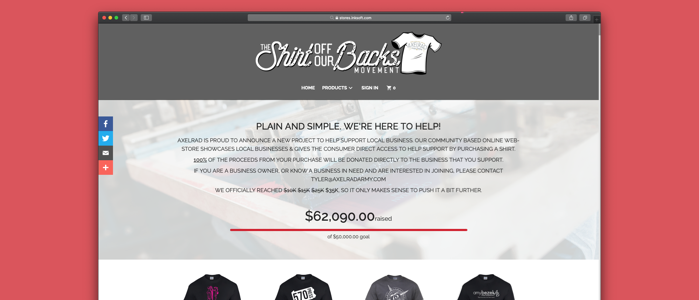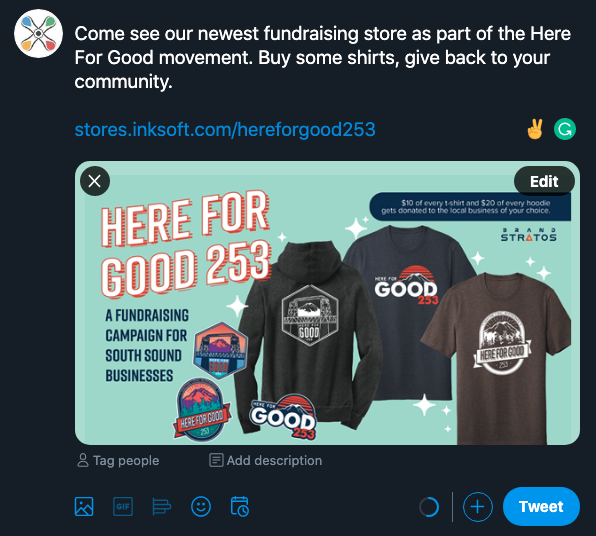Bottom Line Up Front: Once an online store is up and running, the most crucial factor for it hitting its sales potential is how well it’s being marketed. We break down why client participation in promoting the store is so important — and how to get your clients involved in the process easily.
When it comes to an online store, there are certain variables that weigh heavily into how successful the sales results will be. Variables like, do the product offerings match what the target audience wants? Is the store easy to navigate, and are the checkout instructions clear?
But beyond the product offerings and the UX design, one of the biggest variables for success is reach. That is, the number of people who know that the store is up and running, and who know about exactly what’s on offer.
Once the product/store design variables are solid, the most important questions to ask about a client’s online store are these:
- Is the online store reaching its audience?
- Is it surpassing that audience and reaching new waves of people who might just love — and buy — the products too?
These questions are vital in setting your clients’ online stores up for success — and they’re vital in your business’s success too. Keep reading and we’ll show you how.
The Background: Reach

Let’s cover the basics first: in most cases, the greater the reach, the greater the sales. That means that when it comes to your client’s online store, the more people who know about it — and have a way to access it easily — the more sales your client will see.
Online stores are, by and large, much more conducive to increasing reach than a physical storefront is. Physical storefronts require end-customers to be in a specific place within a specific time frame; they require travel, physical interactions with others, and fast decision making.
Especially in today’s world, when something as simple as going to the store carries a decent amount of risk, online stores offer a much-preferred alternative. And personal health and safety aside, they allow end-customers to browse and shop at their own pace, on their own time.
Online stores offer convenience, they offer accessibility, and they offer a profound sense of control over the entire buying experience. So it’s no wonder that consumers all over the country are buying into e-commerce — more than they ever have before.

Which means that your clients’ end-customers are already primed to visit an online store and make a purchase. But before they do that, they need to know about the store. They need to be made aware of what’s being sold, and they need to have a direct link to access it.
Giving your client’s audience (and beyond) the right information at the right time is integral to achieving store traffic — and to achieving higher sales. And, once you’ve versed your clients on how to do it, it’s actually pretty easy.
So make sure they’re just as invested in getting the word out as you are. Because if you do, you’ll see some staggering results.
Client Participation = Increased Reach = Increased Sales
Client participation is just what it sounds like: having your clients engaged in the marketing strategy of their online store.
Instinctively, we can all get a little tense in the shoulders when we hear (or read) the words “˜marketing strategy’ — maybe they bring up apprehension surrounding the potential cost or time commitments required. But your clients should know that participating here, with these marketing strategies, are neither expensive nor time-consuming. In fact, most can be done with a couple of clicks.
No really — we’re serious.

Online stores are great for a bunch of reasons, but they’re especially great when it comes to their shareability. Because they’re so easy (and effective) to share, they come with limitless digital marketing opportunities already embedded.
All your clients have to do is a quick copy/paste job, and throw together a couple of easy sentences, and that’s it — they’ve already executed on their marketing plan. And succeeded in reaching more people. It’s painless, it’s free, and it can be done by anyone — marketing savvy or not.
The point here is: client participation is the key to getting online stores on the map. Your clients are the ones who need to provide the right information to their audience at the right time, but you’re the one that should be giving them the tools — and encouraging them — to do it.
Not sure where to start? We’ve got you covered. Here are some of InkSoft’s customers’ favorite digital marketing tactics to ensure their clients are hitting their reach potential — every time.
- Digital Presence Promotion: Advise your clients to include a click-through promotional banner, box, or ad on their primary website. The more prominent it is, the better. This way, whenever someone already familiar with the brand/organization/school/team arrives on the site, they’re immediately made aware of the online store — and can click-through to see if there’s anything they want to buy with ease.
Example: ABC High School is selling t-shirts for the homecoming game in a custom online store. On the main ABC High School website, there’s a banner reading “Buy your homecoming game t-shirt here!” running across the top of the page.
- Social Media Promotion: Unfortunately, pasting a banner or integrating a content box into the home page isn’t enough for your client to hit their full marketing potential. They have to be active, and intentional, with their promotion — and that comes down to their social media. Your client should be posting on every social platform they have: Facebook, Twitter, Instagram, LinkedIn. If they’re active members with a following — no matter how small — they should be using that to their advantage.
But it’s not just about posting once and forgetting about it. Depending on what kind of store it is (i.e. if it’s an evergreen store or a pop-up store), your client should determine a posting schedule that makes sense. That might be as simple as posting once a week on each platform — the point is to raise awareness and reach more people, and every time there’s a post, both targets are being met.
Example: ABC High School is on Twitter and Facebook. They post once (on each) to introduce the online store to its following one month before the homecoming game, then once more (on each) three weeks before. At 2 weeks out, they post twice (on each) — and the week of, they post two times on Facebook, and three times on Twitter.
(This example doesn’t take into account distribution/delivery times, but it establishes the point: apply urgency as the deadline for action nears through increased posting with deadline reminders.)
- Email Promotion: Main website and social media promotion are great tactics for reaching potential end-customers, but they also come with some limitations. Limitations like, they provide all of the right information — but only if the end-customer is already visiting their page, or scrolling their news feed at just the right time. Email promotion cuts through those limitations, sending the necessary information right to your client’s audience.
Just like with social media promotion, email promotion requires the right scheduling strategy in order to see increased effectiveness. For a pop-up online store that’s only live for a short amount of time, one intro email and one “Last Chance!” email might be enough. For an evergreen online store, email promotions can be used to detail new or seasonal offerings, sales, and special discounts.
Example: ABC High School sends an email (or includes a store-related promotion inside an email) to its email list (parents, students, faculty). It sends a standalone email first, introducing everyone to the online store and reminding them of the homecoming game deadline. Then, the school includes a click-through reminder in every other email/newsletter it sends out before the game — which can be as simple as, “Remember to get your homecoming game t-shirts here!”.
- Client Participation Contract: It might sound aggressive, but the easiest way to make sure clients understand — and are engaged with — the marketing strategies that lead to success is by giving them a contract.
A contract like this works to accomplish a few things: first, it shows your clients how much you care about their sales goals, through putting in the time and effort to help them achieve them. Second, it evokes a sense of professionalism, showing your clients that you have expertise — and you know what works when it comes to hitting those sales goals. And third, it gives them clear-cut instructions that they can follow, taking out any wasted time or confusion from the process.
Client participation contracts are completely customizable, and should vary based on the client, the type of store, and the type of audience. But the one thing they should all offer is clarity. Many InkSoft customers use these contracts as a succinct place to include a posting schedule and the store link, and all agree that they make the marketing process much easier — from both sides.
Example:
Client Participation Contract: ABC School’s Homecoming Store
ABC School will post…
- On main website:
- 1 banner/box/ad on top of homepage, to remain there until the order deadline.
- On Facebook:
- 1 x 4 weeks out from order deadline
- 1 x 3 weeks out from order deadline
- 2 x 2 weeks out from order deadline
- 2 x week of order deadline
- On Twitter:
- 1 x 4 weeks out from order deadline
- 1 x 3 weeks out from order deadline
- 2 x 2 weeks out from order deadline
- 3 x week of order deadline
ABC School will send…
- Emails:
- 1 store intro email to full email list
- Short reminders/click-through buttons in each email/newsletter sent after intro email, until the order deadline
This online store link will be included in every post and email: (Link)
The Wrap Up
The thing is, your clients already have an audience. They already have a pool of people that are invested in them. Whether they’re a school, and they have their whole school community of students, parents, faculty, and alumni, or whether they’re a small business with their own community of customers, fans, and those in the area — they should all be using their people, their connections, to their advantage.
So help them do that. Help them see that with a simple digital marketing strategy — and with eager client participation — they’ll be able to reach the people they should be reaching. And then some.
We never know who a Tweet might reach. We never know which customer might learn about the store while scrolling her newsfeed, make a purchase, and then be so happy with her purchase that she shares the store — with her thousands of followers.
With digital marketing, there are always opportunities for exponential increases in reach — which lead to huge impacts on sales. So make sure your clients are positioned in ways that make those increases possible.
Because there’s nothing worse than a beautifully designed custom online store, filled with kickass products that are exactly what end-customers might be looking for, that nobody knows about.
There’s nothing worse than untapped potential.
So let your clients know just how crucial their participation is to their sales results. Once they’re on-board — and once they start seeing the results that come with their active promotion — they’ll be blown away. By your know-how, and by their store’s success. And that will lead to satisfied clients that keep coming back to you, over and over.
Client participation is a win-win. So get your clients on-board now, and start seeing the impact sooner.
Looking for how to pitch prospects/customers on signing up for an online store?
Look no further. We created an Online Store Marketing Kit, complete with email templates, web copy, and social posts, for you to customize and use freely! The kit includes pitches for Business/Companies, Schools, Teams/Athletic Organizations, and Groups & Clubs, so there’s something for every client.
See our Blog and access the kit below.


